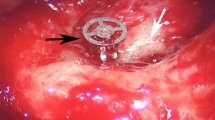Abstract
This study aimed to evaluate the benefit but also the extrusions, dislocations, and failures of a titanium incus prosthesis along with the long-term audiological outcomes. We prospectively collected data from 139 patients undergoing ossiculoplasty using the Fisch titanium incus prosthesis between 2001 and 2016. Overall, 126 patients with at least 6 months of follow-up (mean 4.5 years, range 6–155 months) were analyzed. Patients were grouped as “extrusion” (n = 9, 7%) if the prosthesis extruded, “failure” (n = 22, 18%) if a reoperation was needed concerning the prosthesis, and “stable” (n = 95, 75%) if the prosthesis remained functional in the middle ear. Mean postoperative air bone gaps (ABG) for 0.5–3 kHz for the overall group and the stable group were 19.8 (±11.9) and 15.3 (±7.5), respectively. Long-term results of stable group revealed an ABG (0.5–3 kHz) below 10 dB in 25% and below 20 dB in 81% of the patients. Atelectasis was the most frequent cause of extrusion, which occurred after a mean time of 28.7 months (range 15–48 months). Mean timing for reoperation was 30.7 months (range 5–131 months) in the failure group. There was no significant difference in mean postoperative ABG among patients with or without cholesteatoma, primary or staged ossiculoplasty in cholesteatoma, presence or absence of malleus head at the time of ossiculoplasty, open or closed cavity surgeries, or the degree of pneumatization of the temporal bone. The Fisch titanium incus prosthesis is a reliable alternative to using autologous incus for interposition ossiculoplasty, with similar hearing outcomes. Using this prosthesis, a 15 dB ABG should be expected.




Similar content being viewed by others
References
O’Reilly RC, Cass SP, Hirsch BE, Kamerer DB, Bernat RA, Poznanovic SP (2005) Ossiculoplasty using incus interposition: hearing results and analysis of the middle ear risk index. Otol Neurotol 26(5):853–858
Siddiq M, East D (2004) Long-term hearing results of incus transposition. Clin Otolaryngol Allied Sci 29(2):115–118
House JW, Teufert KB (2001) Extrusion rates and hearing results in ossicular reconstruction. Otolaryngol Head Neck Surg 125(3):135–141
Vrabec JT, Stierman K, Grady JJ (2002) Hydroxyapatite prosthesis extrusion. Otol Neurotol 23(5):653–656
Fisch U, May JS, Linder T (2008) Tympanoplasty, mastoidectomy and stapes surgery, vol 2. Thieme, Stuttgart
Jang C (2002) Changes in external ear resonance after mastoidectomy: open cavity mastoid versus obliterated mastoid cavity. Clin Otolaryngol Allied Sci 27(6):509–511
Cheng JT, Hamade M, Merchant SN, Rosowski JJ, Harrington E, Furlong C (2013) Wave motion on the surface of the human tympanic membrane: holographic measurement and modeling analysis. J Acoust Soc Am 133(2):918–937
Bance M, Rosowski JJ, Adamson RBA (2016) Middle ear mechanics in hearing reconsruction. In: Dornhoffer JL, Gluth MB (eds) The chronic ear. Thieme, New York, pp 62–79
Morris DP, Bance M, van Wijhe RG, Kiefte M, Smith R (2004) Optimum tension for partial ossicular replacement prosthesis reconstruction in the human middle ear. Laryngoscope 114(2):305–308
Yamada H, Goode RL (2010) A self-adjusting ossicular prosthesis containing polyurethane sponge. Otol Neurotol 31(9):1404–1408
Vlaming M, Feenstra L (1986) Studies on the mechanics of the reconstructed human middle ear. Clin Otolaryngol Allied Sci 11(6):411–422
Kelly D, Prendergast PJ, Blayney A (2003) The effect of prosthesis design on vibration of the reconstructed ossicular chain: a comparative finite element analysis of four prostheses. Otol Neurotol 24(1):11–19
Wever EG, Lawrence M (2015) Physiological acoustics. Princeton University Press, Princeton
Meulemans J, Wuyts FL, Forton GE (2013) Middle ear reconstruction using the titanium Kurz Variac partial ossicular replacement prosthesis: functional results. JAMA Otolaryngol Head Neck Surg 139(10):1017–1025
Quesnel S, Teissier N, Viala P, Couloigner V, Van Den Abbeele T (2010) Long term results of ossiculoplasties with partial and total titanium Vario Kurz prostheses in children. Int J Pediatr Otorhinolaryngol 74(11):1226–1229
Iñiguez-Cuadra R, Alobid I, Borés-Domenech A, Menéndez-Colino L-M, Caballero-Borrego M, Bernal-Sprekelsen M (2010) Type III tympanoplasty with titanium total ossicular replacement prosthesis: anatomic and functional results. Otol Neurotol 31(3):409–414
Schmerber S, Troussier J, Dumas G, Lavieille J-P, D-q Nguyen (2006) Hearing results with the titanium ossicular replacement prostheses. Eur Arch Otorhinolaryngol Head Neck 263(4):347–354
Pringle MB, Sunkaraneni VS, Tann N (2014) Is cartilage interposition required for ossiculoplasty with titanium prostheses? Otol Neurotol 35(3):482–488
Coffey CS, Lee FS, Lambert PR (2008) Titanium versus nontitanium prostheses in ossiculoplasty. Laryngoscope 118(9):1650–1658
Hess-Erga J, Møller P, Vassbotn FS (2013) Long-term hearing result using Kurz titanium ossicular implants. Eur Arch Otorhinolaryngol 270(6):1817–1821
Dalchow C, Grün D, Stupp H (2001) Reconstruction of the ossicular chain with titanium implants. Otolaryngol Head Neck Surg 125(6):628–630
Somers T, Van Rompaey V, Claes G, Salembier L, van Dinther J, Andrzej Z, Offeciers E (2012) Ossicular reconstruction: hydroxyapatite bone cement versus incus remodelling. Eur Arch Otorhinolaryngol 269(4):1095–1101
Neudert M, Zahnert T, Lasurashvili N, Bornitz M, Lavcheva Z, Offergeld C (2009) Partial ossicular reconstruction: comparison of three different prostheses in clinical and experimental studies. Otol Neurotol 30(3):332–338
Acknowledgements
We acknowledge the help of Dr. Med. Katia Dalkowski (kdalkowski@online.de) for her illustration.
Author information
Authors and Affiliations
Corresponding author
Ethics declarations
Conflict of interest
The authors have no conflicts of interest to disclose. The study was approved by the hospital Ethical committee. The authors have no sources of financial support or funding to disclose.
Rights and permissions
About this article
Cite this article
Mulazimoglu, S., Saxby, A., Schlegel, C. et al. Titanium incus interposition ossiculoplasty: audiological outcomes and extrusion rates. Eur Arch Otorhinolaryngol 274, 3303–3310 (2017). https://doi.org/10.1007/s00405-017-4634-4
Received:
Accepted:
Published:
Issue Date:
DOI: https://doi.org/10.1007/s00405-017-4634-4




